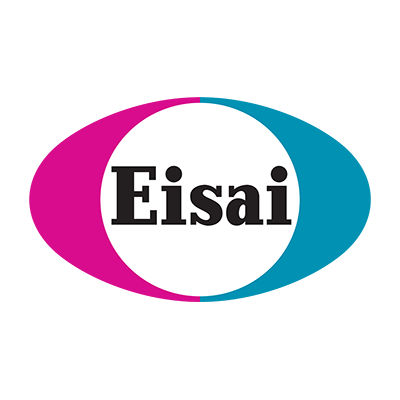预约演示
更新于:2025-05-07
Eisai Ltd.
子公司|Ireland
子公司|Ireland
更新于:2025-05-07
概览
标签
神经系统疾病
呼吸系统疾病
其他疾病
小分子化药
疾病领域得分
一眼洞穿机构专注的疾病领域
暂无数据
技术平台
公司药物应用最多的技术
暂无数据
靶点
公司最常开发的靶点
暂无数据
| 疾病领域 | 数量 |
|---|---|
| 神经系统疾病 | 1 |
| 排名前五的药物类型 | 数量 |
|---|---|
| 小分子化药 | 1 |
| 排名前五的靶点 | 数量 |
|---|---|
| Orexin receptor(食欲素受体) | 1 |
关联
1
项与 Eisai Ltd. 相关的药物作用机制 食欲素受体拮抗剂 |
原研机构 |
最高研发阶段批准上市 |
首次获批国家/地区 加拿大 |
首次获批日期2019-09-03 |
100 项与 Eisai Ltd. 相关的临床结果
登录后查看更多信息
0 项与 Eisai Ltd. 相关的专利(医药)
登录后查看更多信息
212
项与 Eisai Ltd. 相关的文献(医药)2025-04-01·Annals of Oncology
Biomarker analyses from the phase III randomized CLEAR trial: lenvatinib plus pembrolizumab versus sunitinib in advanced renal cell carcinoma
Article
作者: George, S ; Rha, S Y ; Motzer, R J ; Burgents, J E ; Narita, Y ; Huang, J ; Eto, M ; Hutson, T E ; Winquist, E ; Zhao, Z ; Merchan, J R ; Cristescu, R ; Okpara, C E ; Minoshima, Y ; Grünwald, V ; Markensohn, J ; Porta, C ; Choueiri, T K ; Gurney, H ; Sachdev, P
2025-03-28·Journal of the National Comprehensive Cancer Network
TIP25-243: Randomized Study Evaluating Optimal Dose, Efficacy and Safety of E7386 + Lenvatinib Versus Treatment of Physicians' Choice in Advance/Recurrent Endometrial Carcinoma Previously Treated With Anti-PD-(L)1 Immunotherapy
Article
作者: Eskander, Ramez ; Mirza, Mansoor ; Hu, Tianle ; Makker, Vicky ; Lee, Jung-Yun ; Mackay, Helen ; Corr, Bradley ; Wu, Xiaohua ; Oaknin, Ana ; Lorusso, Domenica ; Okpara, Chinyere ; Ray-Coquard, Isabelle ; McKenzie, Jodi ; Gonzalez-Martin, Antonio ; Hasegawa, Kosei ; Dutta, Lea ; Leary, Alexandra
2025-03-20·Journal of Clinical Oncology
First-Line Lenvatinib Plus Pembrolizumab Versus Chemotherapy for Advanced Endometrial Cancer: A Randomized, Open-Label, Phase III Trial
Article
作者: Korach, Jacob ; Orlowski, Robert ; Guedes, João Daniel Cardoso ; Harrison, Michelle ; Graham, Deena M. ; Kaen, Diego Lucas ; Zamora, Liliana Beatriz ; Kryzhanivska, Anna ; Lu, Chien-Hsing ; Lewin, Sharyn ; Santin, Alessandro ; Casado Herraez, Antonio ; Friedlander, Michael ; Stillie, Alison ; Ozerkan, Kemal ; Lv, Weiguo ; Pignata, Sandro ; Lee, Christine ; Guerrero Cabrera, Fernando Felix ; Diaz Redondo, Tamara ; Frentzas, Sophia ; Huang, Yi ; Bollinger, Lauren ; Belonogov, Aleksandr ; Bidziński, Mariusz ; Altintas, Sevilay ; Krasnohrud, Yuliia ; Meniawy, Tarek ; Eminowicz, Gemma ; Jia, Xuemei ; Tarnawski, Rafal ; Zibetti Dal Molin, Graziela ; Danska-Bidzinska, Anna ; Scalici, Jennifer ; Rubio Perez, Maria Jesus ; Cadoo, Karen ; Ethier, Josee-Lyne ; Westhoff, Gina ; Vardar, Mehmet Ali ; Kim, Yong Man ; Villalobos Valencia, Ricardo ; Simsek, Tayup ; Van Gorp, Toon ; Marth, Christian ; Scollo, Paolo ; Escobar Penagos, Jose ; Vasiliev, Aleksandr Gennadievich ; Salutari, Vanda ; de Melo, Andreia Cristina ; Voitko, Nataliia ; Ghamande, Sharad ; Bednarek, Wieslawa ; Nakamura, Kazuto ; Mattar, Andre ; Pan, Lingya ; Kalinka, Ewa ; Hall, Marcia ; Wu, Xiaohua ; Polterauer, Stephan ; Fortin, Suzanne ; Mach, Pawel ; Kedrova, Anna ; Van Le, Linda ; Konecny, Gottfried E. ; Sukhina, Olena ; Beiner, Mario ; Levy, Talia ; Kose, Fatih ; Kaen, Diego ; Rumyantsev, Alexey Alexandrovich ; Blank, Stephanie ; Baurain, Jean-Francois ; Makarycheva, Yulia ; Bessette, Paul ; Kim, Yong Beom ; Shannon, Catherine Margaret ; Makker, Vicky ; Anderson, Charles ; Rykov, Ivan V. ; McKenzie, Jodi ; Damian, Fernanda Bronzon ; Gonzalez Mendoza, Rene Lazaro ; Zhu, Jianqing ; Ellard, Susan ; Zheng, Hong ; Franke, Fabio Andre ; Okpara, Chinyere E. ; Santana, Rosane O. ; Lheureux, Stephanie ; Hughes, Andrew ; Katsumata, Noriyuki ; Kikuchi, Akira ; Kolinsky, Michael ; Magallanes Maciel, Manuel Ernesto ; Nishio, Shin ; Kumar Tyagi, Nidhi ; Kulyaba, Yaroslav ; de Freitas Junior, Ruffo ; Ananda, Sumitra ; Braicu, Elena Ioana ; Bell, Maria ; Ayhan, Ali ; Buscema, Joseph ; Shalkova, Mariia ; MacKay, Helen ; Safina, Sufia Zievna ; Ma, Cailing ; Diakos, Connie ; Samouëlian, Vanessa ; Baron-Hay, Sally ; Wang, Peng-Hui ; Lopez Chuken, Yamil Alonso ; Kim, Sang Wun ; Lisyanskaya, Alla Sergeevna ; Yao, Lili ; Gilbert, Lucy ; Piatnytska, Tetiana ; Braly, Patricia ; Mackowiak-Matejczyk, Beata ; Zamagni, Claudio ; Marmè, Frederik ; Tsunoda, Takuya ; Lin, Wu-Chou ; Svintsitsky, Valentyn ; Gao, Bo ; Kudaka, Wataru ; Magallanes-Maciel, Manuel ; Yao, Shuzhong ; Fehniger, Julia ; Musaeva, Natalia ; Mattar, André ; Amnon, Amit ; Takano, Masashi ; Tinker, Anna ; Bondarenko, Igor ; Hasegawa, Kosei ; Chou, Hung-Hsueh ; Chen, Xiaojun ; Cheng, Wen-Fang ; Sonoda, Kenzo ; Moore, Richard G. ; Casarini, Ignacio Alfredo ; Wu, Yumei ; Naglieri, Emanuele ; Romero Noguera, Ignacio ; Roszak, Andrzej ; Witteler, Ralf ; Romeo Marin, Margarita ; Chekerov, Radoslav ; De Bock, Marlies ; Kobayashi, Yoichi ; Yamagami, Wataru ; An, Ruifang ; Petru, Edgar ; Alfie, Margarita Sonia ; Bidzinski, Mariusz ; Khemka, Vivek ; Yunokawa, Mayu ; Lima, Joao Paulo da Silveira Nogueira ; Zhang, Yu ; Kamiura, Shoji ; Choi, Chel Hun ; Quindos Varela, Maria ; Taus Garcia, Alvaro ; Rubio, M. Jesús ; Lim, Charles ; Corr, Bradley ; Vulsteke, Christof ; Matsumoto, Koji ; Kim, Hee Seung ; Koralewski, Piotr ; Gomez Abuin, Gonzalo ; Horie, Koji ; Khalique, Saira ; Usami, Tomoka ; Urmancheeva, Adiliya Fettekhovna ; Berger, Regina ; Kato, Hidenori ; Suzuki, Nao ; Averina, Hanna ; Zhou, Qi
100 项与 Eisai Ltd. 相关的药物交易
登录后查看更多信息
100 项与 Eisai Ltd. 相关的转化医学
登录后查看更多信息
组织架构
使用我们的机构树数据加速您的研究。
登录
或

管线布局
2025年10月20日管线快照
管线布局中药物为当前组织机构及其子机构作为药物机构进行统计,早期临床1期并入临床1期,临床1/2期并入临床2期,临床2/3期并入临床3期
批准上市
1
登录后查看更多信息
当前项目
| 药物(靶点) | 适应症 | 全球最高研发状态 |
|---|---|---|
莱博雷生 ( Orexin receptor ) | 入睡和睡眠障碍 更多 | 批准上市 |
登录后查看更多信息
药物交易
使用我们的药物交易数据加速您的研究。
登录
或

转化医学
使用我们的转化医学数据加速您的研究。
登录
或

营收
使用 Synapse 探索超过 36 万个组织的财务状况。
登录
或

科研基金(NIH)
访问超过 200 万项资助和基金信息,以提升您的研究之旅。
登录
或

投资
深入了解从初创企业到成熟企业的最新公司投资动态。
登录
或

融资
发掘融资趋势以验证和推进您的投资机会。
登录
或

Eureka LS:
全新生物医药AI Agent 覆盖科研全链路,让突破性发现快人一步
立即开始免费试用!
智慧芽新药情报库是智慧芽专为生命科学人士构建的基于AI的创新药情报平台,助您全方位提升您的研发与决策效率。
立即开始数据试用!
智慧芽新药库数据也通过智慧芽数据服务平台,以API或者数据包形式对外开放,助您更加充分利用智慧芽新药情报信息。
生物序列数据库
生物药研发创新
免费使用
化学结构数据库
小分子化药研发创新
免费使用
